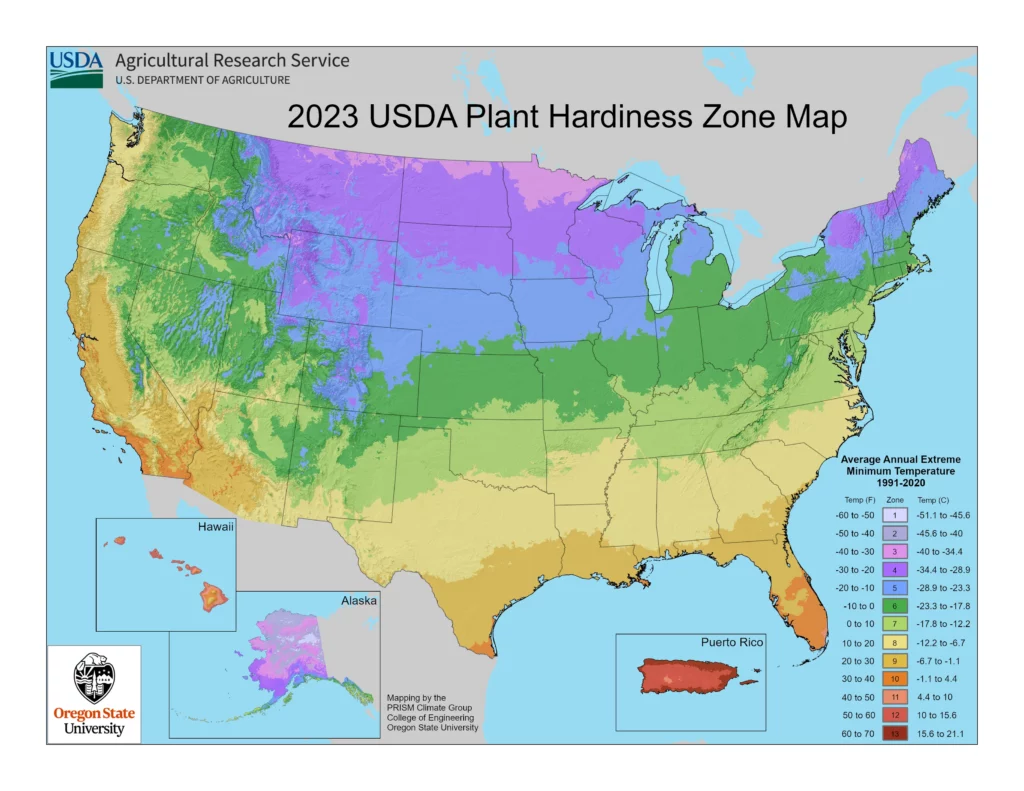When planning your garden, understanding the USDA Plant Hardiness Zone Map is crucial, especially for selecting perennials and scheduling annual plantings. This map, a pivotal resource for gardeners and farmers, guides you in making informed decisions about what will flourish in your area.
The zones delineated on this map are defined by each region’s average annual minimum winter temperature. This is particularly vital for perennials, as it indicates whether a plant can endure the local winter conditions year after year. For annuals, these zones also offer a valuable framework for planning planting times, ensuring they grow during the most favorable conditions of the year.
But how exactly does the USDA define these zones? They are derived from a blend of historical weather data, recent temperature recordings, and local terrain characteristics. The USDA collaborates with experts in horticulture and meteorology to periodically update the map, striving to provide the most current and accurate guidance. While the zones are primarily geared toward understanding cold hardiness for perennials, they also give you a general idea of the heat tolerance levels for your area, an essential consideration for both perennials and annuals in your garden.
In sum, the USDA Plant Hardiness Zone Map is more than just a tool for choosing plants; it’s a foundational guide for planning and nurturing a garden that is in harmony with its local climate, particularly regarding perennial survival and the strategic planting of annuals.
I will show you an easy way to locate your USDA zone. All it takes is a quick visit to the USDA website to find the Plant Hardiness Zone Map. Here’s where you enter your ZIP code into the search bar, and like magic, your zone will appear. But don’t just note the number; you’ll want to understand what the map’s colors tell you.
Each color on the map marks a distinct zone, which is determined by a 10-degree Fahrenheit difference in the average annual minimum temperature. This means you can accurately identify which plants will thrive and which may struggle in your garden. It’s essential to remember that the USDA updates this map regularly to reflect changes in climate patterns. This adaptability is vital in our efforts towards sustainable gardening, as it helps us stay aware of environmental changes.
Of course, you can always dig deeper with the map’s interactive tools. You’ll find out about climate boundaries and even historical weather data, which can be invaluable information for deciding when to plant your tomatoes or whether those tropical plants could survive winter outdoors in your area.
With this newfound knowledge, you can move forward and use these insights to guide your garden planning. Remember, knowing your hardiness zone is one thing, but applying it effectively is where you really see the benefits. In the next section, we’ll explore exactly how to use your zone information to create a thriving garden.

Applying Zone Knowledge to Your Garden Planning
This knowledge will be beneficial once you have determined your USDA plant hardiness zone. It acts as a customized guide to assist you in selecting what to plant and when to plant it. Choose something recommended for your zone that interests you, to ensure your garden’s success.
Understanding your local temperature range, including the minimum temperature for plant survival, and aligning your gardening schedule with your specific climate’s natural cycles is essential. In areas where winter brings freezing temperatures, selecting perennial vegetables that can withstand the cold is crucial for a sustainable and resilient garden. Consider, for example, the robust asparagus. Even after harsh winters, this hardy perennial vegetable emerges yearly, offering a delicious early spring harvest. Another excellent choice is rhubarb, known for its cold tolerance and ability to produce for many years with minimal care.
Also, don’t overlook the value of perennial herbs like chives and sage. These not only survive freezing conditions but can also rejuvenate your garden each spring, adding both flavor and greenery. By integrating such perennial vegetables and herbs into your garden, you create a long-lasting, productive space that aligns with the rhythms of your local climate, ensuring a bountiful harvest for many seasons.
In my opinion, the most exciting aspect of gardening is observing new plants grow. To improve your chances of success, you should plant during the period when your zone experiences optimal growing conditions. For example, long-season vegetables may require an early start in colder zones to mature fully.
When starting a garden, don’t worry about making mistakes. Gardens are forgiving, and you can constantly adjust your approach based on what works best. In addition to selecting individual plants, you should also consider your garden’s overall design and timing. If you want a landscape that offers year-round interest, you must choose various plants that thrive in different seasons within your zone.
Next, I will assist you in connecting the information you have learned about zones with practical steps. In the next section, I will share expert tips to help you maximize your zone-based gardening strategies for success.
Expert Tips for Zone-Based Gardening Success
Gardening is not just about the end result, but the journey itself. It involves a continuous process of learning and adapting to nature. For a thriving garden, it’s essential to understand the unique conditions of your area’s USDA plant hardiness zone. To achieve this, you can seek wisdom from local extension services, which provide tailored advice, workshops, and even soil testing services to enhance your garden’s health and yield.
Every garden has unique microclimates which can create opportunities for growth. You can create a personalized planting strategy by observing and noting these nuances in your garden journal. Your journal can also record changes in your garden over time, allowing you to experiment with new plants suited to slightly warmer or cooler conditions. This will enable you to prepare your garden for the future and make it resilient while still being beautiful.
Gardening is an exploration that requires a balance of knowledge and intuition. Your garden journal is a tool for growth, reflecting the journey of both the gardener and the garden. Therefore, embrace this journey with curiosity, flexibility, and a sense of wonder. A garden that tells a story of adaptation, beauty, and abundance can be chronicled lovingly in the pages of your journal.

